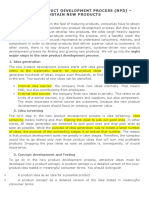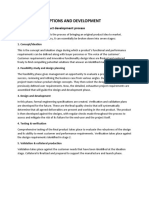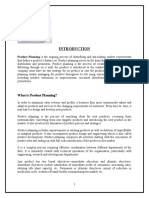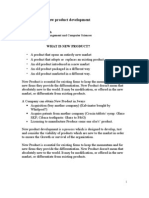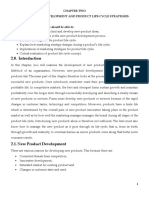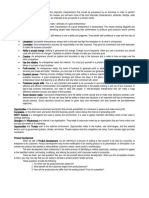Module 5. Product and Service Development
Module 5. Product and Service Development
Uploaded by
Vino LucbanCopyright:
Available Formats
Module 5. Product and Service Development
Module 5. Product and Service Development
Uploaded by
Vino LucbanOriginal Title
Copyright
Available Formats
Share this document
Did you find this document useful?
Is this content inappropriate?
Copyright:
Available Formats
Module 5. Product and Service Development
Module 5. Product and Service Development
Uploaded by
Vino LucbanCopyright:
Available Formats
The Entrepreneurial Mind 1
CYVELL M. ADORA, LPT, CTT
The Entrepreneurial Mind 2
CYVELL M. ADORA, LPT, CTT
LESSON
A. Introduction
In Entrepreneur’s business, product/service development is the term used to describe the complete process of bringing a new
product or service in the market and it's an ongoing practice in which the entire business is looking for opportunities as new
products provide growth promise to businesses that allow them to strengthen their market position. The new product
development process involves the idea generation, product design, and detail engineering; and also involves market research
and marketing analysis. Intense global competition, short product and technology lifecycles, unpredictable consumer buying
patterns and possible market stagnation makes new product development a critical activity in most businesses. Hence, this
chapter explores the new product development process and at the same time sketch outs the product development procedure
in reality where consideration of real-life situation and consumer insight are the main concern. Besides, the chapter; considering
(often entrepreneur), because of their lack of understanding of intellectual property, ignore important steps that they should have
taken to protect these assets; will describe all the important types of intellectual property which have become unique problems
to the Patent and Trademark Office.
B. The Concept of Product/Service
Many entrepreneurs find it difficult to identify a new product/service or a new market opportunity. To start and expand a small
venture, an entrepreneur needs to identify opportunities for domestic and/or international expansion. As the new venture grows
and matures a need for different management skills can occur as well as for a new infusion of the entrepreneurial spirit (corporate
entrepreneurship). Entrepreneurs like Richard China or Mal Mixon, CEO of Invacare, understands this axiom and effectively
manages change by continually adapting organizational culture, structure, procedures, strategic direction, and products in both
a domestic and an international orientation.
Organization's success is dependent on customer satisfaction and delight. Customer satisfaction is achieved through the
development of product and service, which have all attributes required by the customer. A success product or services do not
only have an attractive package design but should be also able to provide robust performance. Thus, product design must be
practical enough for production and powerful enough to provide a competitive advantage.
The essence of product design is to satisfy customer and maximizes the value for the customer at minimum cost. The
merchandise or service should also be able to meet primary needs and desire of the customer. This may not require development
of new merchandise, but an enhancement to existing merchandise or service. Most companies apparently are introducing a
wide variety of smaller, more efficient, and more intelligent products, coupled with a leaner, more efficient approach to operation.
The goal is to create products and services by identifying an emerging trend and to match that trend with the right technology
and understanding of the purchasing dynamics.
A successful start-up depends on its distinctive and compelling proposition. This is how merchandise or services stand out from
the competition and are compelling to the young company’s customers. The merchandise or service will succeed most if it either
eliminates an existing pain or adds significant tangible benefits. It is easier to sell/deliver a new merchandise/service that
eliminates a well-known existing pain, as opposed to sell an item or service that doesn’t clearly solve a potential client’s pain.
There also seems to be a popular myth that anyone can be successful by simply working on any given idea or opportunity. This
isn’t true! You can’t. Most businessmen are very knowledgeable about the merchandise before they start, since even
experienced operators will run into unexpected troubles when they start their new business. Novices generally introduce more
problems than they can deal with, which only undercuts their ability to be lean, fast or effective.
C. Product/Service Development Process
Once the opportunity is selected, and a business model has been designed, the next step is to develop a commercial version
of the opportunity which in most cases is either a product or a service. One of the essential characteristics of a successful
business is exemplified by its ability to continuously and rapidly develop new or improved versions of existing products that
deliver values more than customers expect (Palgrave, 2019.)
Product development is the process through which companies react to market signals, respond to changes in customer demand,
adopt new technologies, foray into new areas, and ensure continuous growth. It is a core process in achieving strategic
objectives, renewal of the company business model and deterring competition from displacing the company from its market
position. Product/service development process is part of the overall new-venture creation process. Even though there are many
models that advocate what the product/service generation process should look like, for this purpose we shall adopt four distinct
stages.
These stages can be referred to as:
1. Idea Generation
2. Incubation
3. Implementation
4. Diffusion
The Entrepreneurial Mind 3
CYVELL M. ADORA, LPT, CTT
The various stages of new product development process are explained next:
1. New Idea Generation
The new product development process starts with search for ideas. Companies have to encourage any new idea coming.
The key to successful domestic and international entrepreneurship is to develop an idea that has a market for the new
product/service idea conceived. Some of the more fruitful sources of ideas for entrepreneurs include consumers, existing
products and services, distribution channels, the federal government, and research and development.
2. Idea Screening
In the 2nd stage, the purpose is to lessen the number of ideas to few vital/valuable ideas. The ideas should be written
down and reviewed each week by an idea committee who should sort the ideas into three groups- Promising Ideas,
Marginal Ideas, and Rejects: Each promising idea should be researched by committee member.
3. Concept Development and Testing
Attractive ideas must be refined into fast able product concepts since people do not purchase ideas but they buy concepts.
Any product idea can be turned into several product concepts. The questions asked probably include:
Who will use the product?
What benefits should the product provide?
When will people consume the produced?
Concept Testing: calls for testing product concepts with an appropriate group of target consumers/customers, and then
getting the consumers’ reactions. At this stage, the concepts can be in words or picture description.
4. Marketing Strategy Development
After testing the new product, the concerned body must develop a preliminary marketing strategy plan for introducing the
new product into the market. The marketing strategy will undergo further refinement in subsequent stages. The marketing
strategy plan consists of three parts: (1) Market size, structure, behavior ;( 2) Planned price, distribution strategy, and
marketing budget of the 1st year; and (3) Long run sales and profit goals, marketing mix strategy.
5. Business Analysis
After management develops product concept and marketing strategy, it can evaluate the proposals’ business
attractiveness. Management needs to prepare sales, cost and profit projections to determine whether they satisfy the
company's objective or not.
Estimated Total Sales: Management needs to estimate whether sales will be high enough to yield satisfactory profit.
Estimating Cost and Profits: After sales forecast the management should estimate the expected cost and profit at various
levels of sales volume.
The company can use other financial measure to evaluate the merit of a new product proposal. The simplest is breakeven
analysis.
6. Product Development
If product concept passes the business test, it moves to R&D or engineering to be developed to one or more physical
version of the product concept. Its goal is to find a proto type that the consumers/customers see as embodying the key
attribute described in the product concept statement.
The Entrepreneurial Mind 4
CYVELL M. ADORA, LPT, CTT
Scientists must not only design the products’ required functional characteristics but also know how to communicate its
psychological aspects through physical cues and how will the consumer/customer react to different colors, sizes, weight
& other physical cues.
When the prototypes are ready, they must be put through regroups functions and consumer/customer tests. Functional
tests are conducted under laboratory & field conditions to make sure that the product performs safely and effectively
(Durability, Speed, Cost, etc) Consumer testing can take variety of forms, from bringing consumers/customers into
laboratory to giving them samples to use in their homes.
7. Market Testing
After management is satisfied with the products’ functional and psychological performance, the product is ready to be
dressed up with the brand name. The goals are to test the new product is more authentic consumer/customer settings and
to learn how large the market is and how consumers/customers and dealers react to handling, using and repurchasing the
actual product.
Most companies know that market testing can yield valuable information about buyers, dealers, marketing program
effectiveness, market potential & other matters. Test Marketing yields several benefits include more reliable forecast of
future sale, and pretesting of alternative of future sale.
8. Commercialization
a) When (Timing): In commercializing, market entry timing is critical. If the company hears about a competitor nearing
the end of its development work, it will face three choices.
b) The 1st choice is First Entry. Under this category, the firm usually enjoys the "first mover advantage" of locking up
key distributors & gaining reputation.
c) The 2nd choice goes with Late Entry Strategy- which has three advantages include:
The competition will have borne the cost of educating the market;
The competing product may reveal fault that the late entrant can avoid; and
The company can learn the size of the market.
d) The 3rd strategy, Parallel Entry can be also chosen by the company to get in the market. The strategy to work, a
prospective businessman can take the advantage of opting for the latest technology and production process and
operate at higher volume of operation. This leads to reduced production cost and production of quality goods and
services. A new businessman can thus provide improved quality goods and services at lower cost and further tap
the market with an innovative marketing approach.
e) Where (Geographical Strategy): The company must decide whether to launch the new product in a single locality, a
region/several region, in the national/international market.
f) To Whom (Target-Market-Prospect): Within the rollout markets, the company must target its distribution and
promotion to the best prospect group. Prime prospects for a new consumer/customer’s product would ideally have
the following characteristics:
They would be early adapters;
They would be heavy users;
They would be Opinion leaders; and
Could be reached at low cost.
g) How (Introductory Markets Strategy): To sequence and coordinate many actives involved in launching a new product
may/can use network-planning techniques such as Critical Path Scheduling (CPS).
D. Legal and Regulatory Frameworks for Entrepreneurs
Since there are many options that an entrepreneur can choose in setting up an organization, it will be necessary to understand
all the advantages and disadvantages of each regarding such issues as liability, taxes, continuity, transferability of interest, costs
of setting up, and attractiveness for raising capital. Legal advice for these agreements is necessary to ensure that the most
appropriate decisions have been made.
One of the challenges the novice entrepreneur will face as she goes into business understands the regulatory environment
which is made up of numerous laws and regulations. To operate as a legal businessperson and protect the business from
unnecessary suits and liabilities, the entrepreneur needs to understand the various laws that govern his/her business. Following
are the key legal issues for the entrepreneur.
The Entrepreneurial Mind 5
CYVELL M. ADORA, LPT, CTT
E. Intellectual Property Protection/Product/Service Protection
E.1 What is Intellectual Property?
Intellectual Property which includes patents, trademarks, copyrights, and trade secrets represents important assets to the
entrepreneur and should be understood even before engaging the services of an attorney. Too often entrepreneurs, because of
their lack of understanding of intellectual property, ignore important steps that they should have taken to protect these assets.
Intellectual property is a legal definition of ideas, inventions, artistic works and other commercially viable products created out
of one's own mental processes. In the same sense that real estate titles establish ownership of tangible items, intellectual
property is protected by such legal means as patents, copyrights, and trademark registrations. In order to enjoy the benefits
arising from the exclusive ownership of these properties, the entrepreneur needs to protect these assets by the relevant law.
This is the reason why’ experts strongly recommend that those in creative fields seek protection through official registration of
their intellectual properties.
Philippine Laws on Intellectual Property
✓ R.A. 8293
An Act prescribing the Intellectual Property Code and establishing the Intellectual Property Office, providing for its powers
and functions, and for other purposes
✓ R.A. 165
An Act creating a patent office, prescribing its powers and duties, regulating the issuance of patents, and appropriating
funds therefore
✓ R.A. 166
An Act to provide for the registration and protection of trade-marks, trade-names, and service marks, defining unfair
competition and false marking and providing remedies against the same, and for other purposes
E.2 Patents
An entrepreneur who invents a new thing or improves an existing invention needs to get legal protection for her invention through
a patent right. A patent is a contract between an inventor and the government in which the government, in exchange for
disclosure of the invention, grants the inventor the exclusive right to enjoy the benefits resulting' from the possession of the
patent.
Utility Patent: A utility patent protects any new invention or functional improvements on existing inventions.
Design Patent: This patent protects the appearance of an object and covers new, original, ornamental, and unobvious
designs for articles of manufacture. Like utility patents, design patents provide the inventor with-exclusive right to make,
use and/or sell an item having the ornamental appearance protected by the patent. This patent is appropriate when the
basic product already exists in the marketplace and is not being improved in function but only in style. These patents are
particularly important to companies such as shoe producers and product package design firms that need to protect their
ornamental designs.
A patent provides the owner with exclusive rights to hold, transfer, and license the production and sale of a product/process. It
is an intellectual property right and It is issued by government to the inventor. This exclusive property right can be granted for a
number of years depending on the country’s laws and type of property. Patents are property rights that can be sold and
transferred, willed as well as licensed and at times used as collateral.
What Can Be Patented Then?
✓ Processes: Methods of production, research, testing, analysis, technologies with new applications.
✓ Machines: Products, instruments, physical objects.
✓ Manufactures: Combinations of physical matter not naturally found.
✓ Composition of matter: Chemical compounds, medicines, etc.
E.3 Trademarks
A trademark may be a word, symbol, design, or some combination of such, or it could be a slogan or even a particular sound
that identifies the source or sponsorship of certain goods or services.
These are distinctive names, marks, symbols or motto identified with a company’s product or service and registered by
government offices. Unlike the patent, a trademark can last indefinitely, as long as the mark continues to perform its indicated
function. Trademarks unlike patents are periodically renewed unless invalidated by cancellations, abandonment, or other
technical registration/renewal issues.
The Entrepreneurial Mind 6
CYVELL M. ADORA, LPT, CTT
Benefits of a Registered Trademark
✓ It provides notice to everyone that you have exclusive rights to the use of the mark throughout the territorial limits of the
country.
✓ It entitles you to sue in federal court for trademark infringement, which can result in recovery of profits, damages, and
costs.
✓ It establishes incontestable rights regarding the commercial use of the mark.
✓ It establishes the right to deposit registration with customs to prevent importation of goods with a similar mark.
✓ It entitles you to use the notice of registration (®).
✓ It provides a basis for filing trademark application in foreign countries.
E.4 Copyrights
Copyright is a right given to prevent others from printing, copying, or publishing any original works of authorship. Copyrights
provide exclusive rights to creative individuals for the protection of literary or artistic productions. It protects original works of
authorship including literary, dramatic, musical, and artistic works, such as poetry, novels, movies, songs, computer software,
and architecture. They pertain to intellectual property. Usually, copyrights are valid for the life of the inventor plus a few decades.
F. Intellectual Property System in the Philippines
The Intellectual Property Code of the Philippines (IPC) aims to protect the exclusive rights of scientists, inventors, artists, and
other gifted citizens to their intellectual property and creation. To help you, here is a quick guide to some of the different types
of registrable IPs in the country.
The Different Types of Intellectual Property Rights in the Philippines
1. Patent
A patent refers to any technical solution to a problem in any field of human
activity which is new, involves an inventive step, and is industrially applicable.
Why Register?
The Patentee will be protected from the unauthorized appropriation or
commercial use of his or her patented product or process.
Eligibility
The product must be new, inventive, and industrially applicable. It may be, or
may relate to a product, a process, or an improvement of any of the foregoing.
Term of Protection
It is valid for 20 years counted from the filing date of the application. After the
lapse of four years, an annual fee must be paid to maintain the patent.
2. Trademark
A trademark is a work, a group of words, signs, symbols, logos, or a
combination that identifies and differentiates a product, service, or
entity from another.
Why Register?
The trademark owner may prevent third persons from using identical
or similar goods or services, where such use would result in a
likelihood of confusion.
Eligibility
IPOPHL considers the distinctiveness of registrable marks such as a
word, figurative (with or without words), 3D, stamped marks or
marked with container of goods.
Term of Protection
It is valid for 10 years and is renewable for another 10 years. Marks
can be protected in perpetuity through timely filing of DAU and regular
renewal of the trademark.
The Entrepreneurial Mind 7
CYVELL M. ADORA, LPT, CTT
3. Copyright
Copyright refers to the right over literary and artistic works which are
protected from the moment of creation.
Why Register?
Registration allows the copyright owner to prevent the unauthorized
reproduction of the work.
Eligibility
IPC immediately reserves the owner’s rights from the moment of
creation. However, its protection can be extended to the expression of
the idea in a tangible form.
Term of Protection
Generally, the term of protection lasts for the creator’s lifetime and 50
years succeeding their death. However, the term may vary depending
on the type of work.
4. Utility Model
Generally refers to an improvement or an implementation of an existing
industrial product even if not possessed of the quality of invention.
Why Register?
Utility Model (UM) rights allow the holder to prevent others from
commercially using the registered UM without his authorization.
Eligibility
The UM may be of any technical solution to a problem in any field of
human activity. It must also be new and industrially applicable.
Term of Protection
Protection is valid up until the end of the seventh year after the filing date
of the application and is non-renewable.
5. Industrial Design
An industrial design mainly refers to the visual or aesthetic
aspect of a product or an article of manufacture.
Why Register?
Allows the right holder to prevent third parties from making,
selling, and importing copies when used for commercial
purposes.
Eligibility
The industrial design must be a new or an original creation.
Term of Protection
Protection is valid for 5 years and is renewable for only two
consecutive periods of 5 years.
Confidently Protect Your Intellectual Properties
Choosing the appropriate IP rights for your product, service, or business can help ensure that your brand, product, process,
mark, designs, and literary or artistic creations are protected for the duration of its existence.
END OF MODULE 5
The Entrepreneurial Mind 8
CYVELL M. ADORA, LPT, CTT
You might also like
- The New Product Development ProcessDocument4 pagesThe New Product Development ProcessDileepNo ratings yet
- An Integrated Perspective On The Future of Mobility, Part 2: Transforming Urban DeliveryDocument48 pagesAn Integrated Perspective On The Future of Mobility, Part 2: Transforming Urban DeliveryMustafa YilmazNo ratings yet
- Gillette IndonesiaDocument7 pagesGillette IndonesiayasirghufranNo ratings yet
- Nonprofit Marketing Plan Template 1 AprilDocument2 pagesNonprofit Marketing Plan Template 1 Aprilpetra kroonNo ratings yet
- Entrepreneurship CH 4Document19 pagesEntrepreneurship CH 4AYELENo ratings yet
- Enter ch-4 PPT NewDocument33 pagesEnter ch-4 PPT NewYemane Admasu GebresilassieNo ratings yet
- Chapter 4: Product/Service DevelopmentDocument11 pagesChapter 4: Product/Service Developmentfeyeko aberaNo ratings yet
- Chapter 4Document12 pagesChapter 4AYNETU TEREFENo ratings yet
- New Product Options and DevelopmentDocument6 pagesNew Product Options and Developmentkavya reddyNo ratings yet
- Enter PPT ch-4Document40 pagesEnter PPT ch-4DeATHuMmEr1911No ratings yet
- Enter Chapter FourDocument8 pagesEnter Chapter FourDaroo D.TNo ratings yet
- Chapter 4Document9 pagesChapter 4Elijah IbsaNo ratings yet
- IM 4th SemDocument20 pagesIM 4th Semdarthvader005No ratings yet
- Tech and InnovationDocument6 pagesTech and InnovationChristopherNo ratings yet
- Week 2 Learning Outcome 2: Select Business Idea Based On The Criteria and Techniques SetDocument11 pagesWeek 2 Learning Outcome 2: Select Business Idea Based On The Criteria and Techniques SetTed Kendrick RamosNo ratings yet
- International MarketingDocument27 pagesInternational MarketingAmishi TrivediNo ratings yet
- UNIT 2 MarketingDocument10 pagesUNIT 2 MarketingMaite Toquero IriarteNo ratings yet
- Chap - 4ccDocument27 pagesChap - 4cctot stephenNo ratings yet
- Product Planning and DevelopmentDocument5 pagesProduct Planning and Developmentbabunaidu2006No ratings yet
- Product DevelopmentDocument41 pagesProduct DevelopmentJohn Rey SR SoveranoNo ratings yet
- POM Unit IIDocument13 pagesPOM Unit IIShiVâ SãiNo ratings yet
- Week 6 Handout PDFDocument7 pagesWeek 6 Handout PDFkiks fernsNo ratings yet
- ENTRE Chapter 5 SummaryDocument5 pagesENTRE Chapter 5 SummaryGin Louise Condino75% (4)
- CH 4 NewDocument27 pagesCH 4 NewEliyas BeniyamNo ratings yet
- HRDM Elec 104 SG 7Document7 pagesHRDM Elec 104 SG 7sorianorhealyn28No ratings yet
- International Product Development Strategy: Few ExampleDocument20 pagesInternational Product Development Strategy: Few ExamplePankaj MishraNo ratings yet
- Chap 1 - Product DecisionsDocument39 pagesChap 1 - Product Decisions2852 Takmoge AdityaNo ratings yet
- Discovering New Product Development StrategyDocument7 pagesDiscovering New Product Development StrategyLi An BautistaNo ratings yet
- New Product Development - SaiDocument14 pagesNew Product Development - Saisainath89100% (1)
- Grade 8 Developing A ProductDocument25 pagesGrade 8 Developing A ProductjosskevynbonifacioNo ratings yet
- Enter PPT ch-4Document36 pagesEnter PPT ch-4jemsNo ratings yet
- New Product Development and Challenges Report Final DraftDocument21 pagesNew Product Development and Challenges Report Final DraftUzma SalmanNo ratings yet
- New Product Development Unit 1Document22 pagesNew Product Development Unit 1Vinod MohiteNo ratings yet
- The New Product Development ProcessDocument5 pagesThe New Product Development Processkhalid100% (1)
- The Idea Generation ProcessDocument26 pagesThe Idea Generation ProcessDaud ShafeeqNo ratings yet
- EMPC 102 MODULE 2 Production Mngt. L3Document6 pagesEMPC 102 MODULE 2 Production Mngt. L3fraudgan2No ratings yet
- Chapter 2-NPD and PLCDocument23 pagesChapter 2-NPD and PLCKaleab TessemaNo ratings yet
- PRP 111 Chapter 9 Notes Week 9Document8 pagesPRP 111 Chapter 9 Notes Week 9Selen BİLGİNER HALEFOĞLUNo ratings yet
- Product and Brand - CH 2Document9 pagesProduct and Brand - CH 2hassoviyan9No ratings yet
- Bam 216 Note 23Document22 pagesBam 216 Note 23ayobamiolatayo355No ratings yet
- AE 413 Lecture 6 New Product Development Process 2023-2024Document5 pagesAE 413 Lecture 6 New Product Development Process 2023-2024Jamali AdamNo ratings yet
- New Product Development StrategyDocument6 pagesNew Product Development Strategysomebodystopme21No ratings yet
- Name. Moin Khan Roll No. 12 Subject. International Business Assignment No.3 Submitted To .Sir Zafar IqbalDocument6 pagesName. Moin Khan Roll No. 12 Subject. International Business Assignment No.3 Submitted To .Sir Zafar IqbalMoin KhanNo ratings yet
- New Product PlanningDocument11 pagesNew Product PlanningAnonymous AXFDWDIweNo ratings yet
- CH 4 SirriDocument17 pagesCH 4 SirriAliyi MohammedNo ratings yet
- New Product Development For Small CompaniesDocument6 pagesNew Product Development For Small CompaniesMadhuri KetaNo ratings yet
- Marketing MAnagement Module 8 and 9Document19 pagesMarketing MAnagement Module 8 and 9202201277No ratings yet
- Unit I Introduction New VentureDocument61 pagesUnit I Introduction New VentureJatin Mandloi (Jatin Panwar)No ratings yet
- Marketing Managemnt Assignment: Ans 1) As A Newly Appointed Product Manager of Balaji Wafers, If I Was Asked To Develop ADocument9 pagesMarketing Managemnt Assignment: Ans 1) As A Newly Appointed Product Manager of Balaji Wafers, If I Was Asked To Develop Abikahiw507No ratings yet
- CH 04 Product & Service ConceptDocument8 pagesCH 04 Product & Service ConceptWondmageneUrgessaNo ratings yet
- CH 4 Product & Service ConceptDocument10 pagesCH 4 Product & Service Conceptkiya kooNo ratings yet
- Chapter Four Product and Service ConceptsDocument11 pagesChapter Four Product and Service ConceptsROBSANNo ratings yet
- Techno - Entrepreneurship PPT 2Document14 pagesTechno - Entrepreneurship PPT 2Ti Amo Per SempreNo ratings yet
- NEW Development: Unit Product ProductDocument13 pagesNEW Development: Unit Product Product009sidNo ratings yet
- Feseability AnalysisDocument41 pagesFeseability Analysistester accountNo ratings yet
- CHAPTER - 4product and Service ConceptDocument29 pagesCHAPTER - 4product and Service ConcepttemesgenNo ratings yet
- Tle 10Document4 pagesTle 10Paul RunnerNo ratings yet
- M2.1 Product DevelopmentDocument12 pagesM2.1 Product DevelopmentCharmaigne MañoNo ratings yet
- New Product Development ProcessDocument15 pagesNew Product Development Processtrleon113No ratings yet
- PME Unit-2 NOTESDocument7 pagesPME Unit-2 NOTESPRATHAM PANDEYNo ratings yet
- New Product Development Essentials: Hands-on Help for Small Manufacturers and Smart Technical People: No Nonsence Manuals, #2From EverandNew Product Development Essentials: Hands-on Help for Small Manufacturers and Smart Technical People: No Nonsence Manuals, #2Rating: 4 out of 5 stars4/5 (1)
- Operations StructureDocument1 pageOperations StructurePranit GaikarNo ratings yet
- Interest, Commission, and DiscountsDocument3 pagesInterest, Commission, and DiscountsJulius Caesar ColladoNo ratings yet
- Full-Service Digital Agency EZ Rankings To Move From .Org ToDocument4 pagesFull-Service Digital Agency EZ Rankings To Move From .Org ToPR.comNo ratings yet
- Defining Specifications For Derivation of Standard AccountDocument4 pagesDefining Specifications For Derivation of Standard Accountshiva1912No ratings yet
- Hksir400 - Revised Dec 2012Document69 pagesHksir400 - Revised Dec 2012Shawn TaiNo ratings yet
- CEE CpE CEE109 Wata UpdateDocument84 pagesCEE CpE CEE109 Wata UpdateJOYNo ratings yet
- CPA Firm Involved AdelphiaDocument2 pagesCPA Firm Involved AdelphiaHenny FaustaNo ratings yet
- Article Review - VANZODocument4 pagesArticle Review - VANZOAKMALNo ratings yet
- The Consumer Decision MakingDocument4 pagesThe Consumer Decision MakingMANAV VASHISHTHANo ratings yet
- HKSTP HKSQ Innoms Seminar 20150124 LottoDocument29 pagesHKSTP HKSQ Innoms Seminar 20150124 LottovpascarielloNo ratings yet
- Committee of Supply Sitting 2008 - Part 2, Speech by Mrs Yu-Foo Yee Shoon, 5 Mar 2008Document10 pagesCommittee of Supply Sitting 2008 - Part 2, Speech by Mrs Yu-Foo Yee Shoon, 5 Mar 2008dbmcysNo ratings yet
- Project TOEICDocument10 pagesProject TOEICAlbain BouyouNo ratings yet
- Quality ManagementDocument15 pagesQuality ManagementMohammad Anisuzzaman0% (2)
- CL Test Unit 3Document4 pagesCL Test Unit 3VbNo ratings yet
- Eu CMDDocument22 pagesEu CMDVasand SundarrajanNo ratings yet
- Dokumen - Tips Biryani-ParadiseDocument20 pagesDokumen - Tips Biryani-ParadisethejyprakashNo ratings yet
- Agile Poster 2018 Ver20 DandyDocument1 pageAgile Poster 2018 Ver20 DandyThe FixxxerNo ratings yet
- FGO Handbook 2017 Edition Update 220Document112 pagesFGO Handbook 2017 Edition Update 220Karen RuizNo ratings yet
- Bibhu Resume Schulich Amdocs PMODocument3 pagesBibhu Resume Schulich Amdocs PMObibs31No ratings yet
- Kelompok 2Document30 pagesKelompok 2edith apiNo ratings yet
- Contractor Safety Management Guideline CGL1034 Ver 1.6Document51 pagesContractor Safety Management Guideline CGL1034 Ver 1.6Nurman SyahrulNo ratings yet
- TALLER 5 InglesDocument7 pagesTALLER 5 InglesMari Pájaro ZabaletaNo ratings yet
- Tata India Consumer FundDocument1 pageTata India Consumer FundRahul MalikNo ratings yet
- Internship Report On Foreign ExchangeDocument38 pagesInternship Report On Foreign ExchangeJahid Hasan ShaonNo ratings yet
- MHRM ProjectDocument5 pagesMHRM ProjectUrvi ShahNo ratings yet
- How Prepared Is India To Face Disasters??: The Roots of NDRFDocument5 pagesHow Prepared Is India To Face Disasters??: The Roots of NDRFPriyanka NandaniNo ratings yet
- Entertainment Music Marketing Promotions Manager in San Francisco Bay CA Resume Dan Phippen in San Francisco Bay CA Resume Dan PhippenDocument2 pagesEntertainment Music Marketing Promotions Manager in San Francisco Bay CA Resume Dan Phippen in San Francisco Bay CA Resume Dan PhippenDanPhippenNo ratings yet
